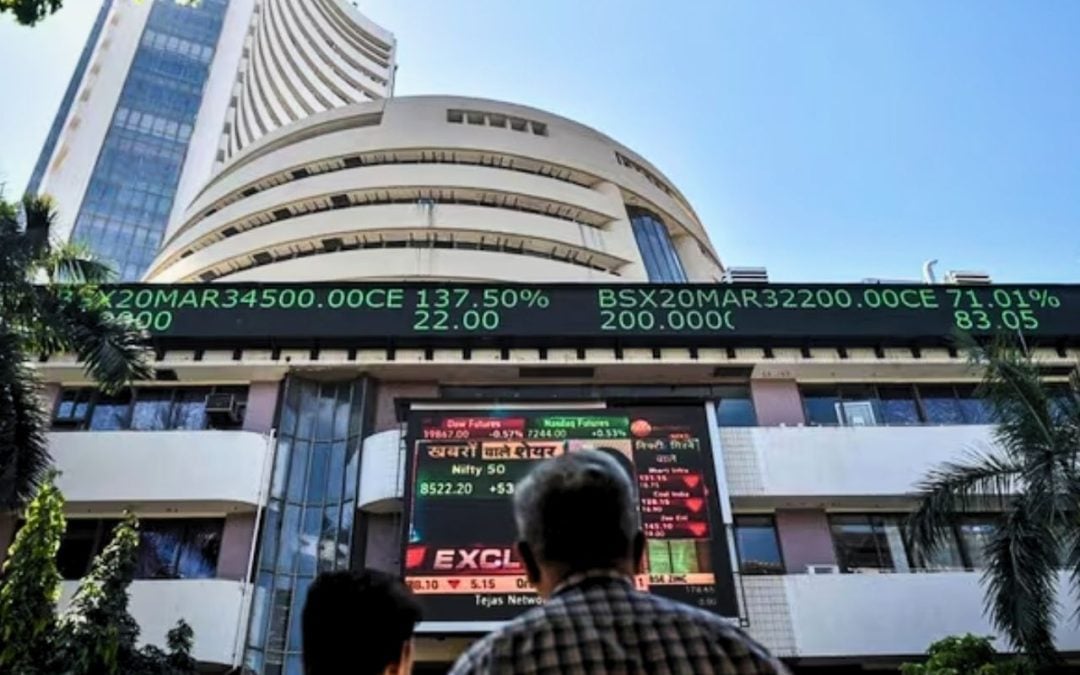Today, we recommend two stocks, one from the IT sector and another from the Automobile sector, recommended by the Trade Brains Portal, to buy for an upside potential of more than 22%. The IT sector stands as a key pillar of India’s economic growth, fuelled by increasing adoption of artificial intelligence, cloud modernisation initiatives, and the rapid expansion of Global Capability Centres (GCCs).
Meanwhile, the Indian automobile industry stands as a key pillar of the economy, significantly contributing to GDP growth and job creation through its extensive manufacturing network and rising exports, particularly in segments like tractors, two-wheelers, and three-wheelers. We also analysed the market’s performance on Friday to understand what may lie ahead for the stock indices in the coming days.
1. HCL Technologies Ltd
- CMP: Rs 1,524
- Target: Rs 1,870
- Upside: 22.7%
- Time frame: 12 Months
To view the report for the stock mentioned above or explore other stock recommendations, click here
Why it’s recommended
HCLTech is a leading global technology enterprise with over 226,640 professionals operating across 60 countries. The company provides advanced solutions in digital transformation, engineering, cloud computing, and artificial intelligence, supported by a broad range of technology services and products. It collaborates with clients across major industries, offering customised solutions for sectors including Financial Services, Manufacturing, Life Sciences and Healthcare, High Tech, Semiconductors, Telecom and Media, Retail and Consumer Packaged Goods (CPG), and Public Services.
In Q2 FY26, HCLTech reported a 10.7% year-on-year (YoY) increase in revenue to Rs 31,942 crore, up from Rs 28,862 crore in Q2 FY25. EBIT grew 3.5% YoY to Rs 5,550 crore, compared to Rs 5,362 crore a year earlier. Net profit remained flat at Rs 4,235 crore, with a net profit margin of 13.3%, representing a 10.2% quarter-on-quarter (QoQ) increase and a stable YoY performance. The company declared a dividend of Rs 12 per share, while its Free Cash Flow-to-Net Income ratio stood at 125%. Total Contract Value (TCV) for new deal wins reached USD 2,569 million, reflecting a 41.8% QoQ and 15.8% YoY increase.
Demand for HCLTech’s AI-driven solutions continued to strengthen, with AI-related revenue surpassing USD 100 million in Q2 FY26. The company also achieved new bookings exceeding USD 2.5 billion for the first time, an accomplishment achieved without reliance on mega deals. Management emphasised reducing dependence on H-1B visas and boosting domestic hiring. The LTM attrition rate declined to 12.6%, compared to 12.9% in Q2 FY25.
For FY26, HCLTech expects overall revenue growth between 3.0% and 5.0% YoY, and services revenue growth between 4.0% and 5.0% YoY, both on a constant currency basis. The EBIT margin is projected to be within 17.0%-18.0%. Recently, the company partnered with GSMA, a global body that unites the mobile ecosystem, to drive telecom innovation through the GSMA Open Gateway initiative.
Risk Factor
HCLTech earns the majority of its revenue from international clients and primarily receives payments in foreign currencies. Its client base mainly consists of corporations located in the US, Europe, and other global markets. Since the company also operates delivery teams across multiple countries, a significant portion of its expenses is incurred in foreign currencies. Consequently, HCLTech is exposed to the risk of economic losses arising from fluctuations in exchange rates.
2. Bajaj Auto Ltd
- CMP: Rs 9,076
- Target: Rs 10,600
- Upside: 16.8%
- Time frame: 12 Months
To view the report for the stock mentioned above or explore other stock recommendations, click here
Why it’s recommended
Bajaj Auto, the flagship company of the Bajaj Group, is a leading manufacturer of two and three-wheelers with exports to more than 79 countries. It is India’s second-largest motorcycle producer, the top two-wheeler exporter, and the world’s largest three-wheeler manufacturer. Operating from five production facilities with a combined annual capacity of 7.2 million units, Bajaj Auto was the first in its segment to cross a market capitalisation of Rs 2 trillion. The company has a diverse product portfolio, a strong global presence, and ranks among the top five players in India’s electric two-wheeler market through its Chetak brand.
In Q1 FY26, Bajaj Auto reported revenue from operations of Rs 13,133.35 crore, marking a 10% year-on-year growth driven by robust performance in exports, commercial vehicles, premium motorcycles, and electric scooters. The company achieved double-digit growth across Africa, Latin America, and Asia and expects export growth of over 20% in the coming years.
EBITDA stood at Rs 3,301.92 crore, while PAT was Rs 2,210.44 crore. During the quarter, Bajaj Auto sold 5,29,344 two-wheelers and 1,05,464 commercial vehicles in the domestic market. From July to September 2025, domestic sales totalled 596,576 units in the two-wheeler segment and 144,217 units in commercial vehicles.
Q1 FY26 marked the eighth consecutive quarter where commercial vehicle sales exceeded 1,00,000 units, underscoring Bajaj Auto’s continued leadership in the electric three-wheeler (3W EV) segment. In FY25, the company held a 75.7% share of the internal combustion engine (ICE) three-wheeler market and a 52.4% share of the ICE three-wheeler goods carrier segment. In Q1 FY26, Bajaj Auto captured over 35% of the e-auto market. Under the PLI scheme, the company has pledged to invest Rs 1,000 crore over five years, with a planned capex of Rs 600-700 crore in FY25-FY26, primarily allocated toward maintenance activities.
Risk Factor
The performance of the automobile industry is closely tied to the nation’s overall macroeconomic conditions. Geopolitical factors, such as the tariffs imposed by the Trump administration, have the potential to disrupt supply chains and raise costs across the sector. Additionally, broader economic influences like global inflation, changes in domestic demand and consumer behaviour, fluctuations in raw material availability, and declining per capita income in several economies can weaken consumer purchasing power and slow industry growth. The two-wheeler market, in particular, remains intensely competitive, with major players such as Hero MotoCorp, Honda Motorcycles, Suzuki Motorcycle, and TVS Motors regularly introducing new models to expand their market share.
Market Recap – October 24, 2025
On Friday, the Nifty 50 opened on a mildly positive note at 25,935.10, up 43.7 points from its previous close of 25,891.40. However, the index failed to sustain early gains and moved downward throughout the session, hitting an intraday low of 25,718.20 before closing at 25,795.15, down 96.25 points (-0.37%). Despite the decline, the Nifty stayed above all major moving averages (20/50/100/200-day EMAs), reflecting strong underlying technical support.
The BSE Sensex followed a similar trajectory, opening higher at 84,667.23 (up 110.83 points from the previous close of 84,556.40) before slipping below the 84,000 mark to a day’s low of 83,957.15. The index eventually settled at 84,211.88, down 344.52 points (-0.41%). Both benchmarks ended the week in negative territory, with RSI values near the overbought zone, 67.92 for Nifty 50 and 67.78 for Sensex. The Bank Nifty also closed lower by 378.45 points (-0.65%) at 57,699.60, weighed down by profit booking and uncertainty over the US-India trade deal. Investors also remained cautious ahead of the US CPI data release later in the day.
Among sectoral indices, most ended in the red except for a few gainers. The Nifty Metal Index was the top performer, rising 1.03% (105.60 points) to 10,347.45, driven by strong gains in Hindalco Industries, Hindustan Copper, National Aluminium, and Vedanta, which advanced up to 4.04%. The Nifty Oil & Gas Index also added 0.20% (22.90 points) to 11,624.05, led by ONGC, Petronet LNG, GAIL, and Oil India, all up about 1%. The Nifty Realty Index ended slightly higher at 940.90 (+0.18%), supported by SignatureGlobal India (+3.97%), along with modest gains in Oberoi Realty, Prestige Estates, and Godrej Properties (up to 1.55%).
On the downside, the Nifty Health Index was the biggest laggard, falling 0.83% (-123.80 points) to 14,862.85. Cipla led the declines with a 3.69% drop, followed by losses in Max Healthcare, Glenmark Pharma, and Apollo Hospitals (down up to 2.22%). The Nifty Private Bank Index slipped 0.81% (-231.85 points) to 28,335.25, dragged by Kotak Mahindra Bank, HDFC Bank, Axis Bank, and IDFC First Bank, which fell as much as 1.73%. The Nifty FMCG Index also closed lower by 0.75% (-424.35 points) at 56,348.10.
In the broader Asian markets, sentiment was mostly positive. Japan’s Nikkei 225 rose 1.26% (+618.39 points) to 49,260.00, Hong Kong’s Hang Seng advanced 0.78% (+203.02) to 26,171.00, China’s Shanghai Composite climbed 0.71% (+27.90) to 3,950.31, and South Korea’s KOSPI surged 2.44% (+96.03) to 3,941.59. As of 4:05 p.m. IST, U.S. Dow Jones Futures were up 0.15% (+63.99 points) at 46,801.59.
For the week, the broader indices posted modest gains, with the Nifty 50 rising 85.30 points (+0.33%) to close near the 25,800 mark at 25,795.15. During the week, the index also reached a 52-week high of 26,104.20, briefly crossing above the 26,000 level.
Disclaimer

The views and investment tips expressed by investment experts/broking houses/rating agencies on tradebrains.in are their own, and not that of the website or its management. Investing in equities poses a risk of financial losses. Investors must therefore exercise due caution while investing or trading in stocks. Trade Brains Technologies Private Limited or the author are not liable for any losses caused as a result of the decision based on this article. Please consult your investment advisor before investing.
About: Trade Brains Portal is a stock analysis platform. Its trade name is Dailyraven Technologies Private Limited, and its SEBI-registered research analyst registration number is INH000015729.
Investments in securities are subject to market risks. Read all the related documents carefully before investing.
Registration granted by SEBI and certification from NISM in no way guarantee performance of the intermediary or provide any assurance of returns to investors.





